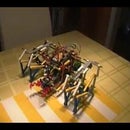Introduction: How to Test the Lawsin Linkage As Appendages for Robot Locomotion
The Lawsin Linkage, sometimes called the Bowtie Truss,is a double cantilever truss system with connecting elements (links) in triangular frames. The structure, which forms like a bow-tie or a double inverted king posts, was developed by Joey Lawsin in 1988 to simulate the walking cadence of his biotronics animals. The linkage was designed to meet the following criteria:
1. It must carry out a walking cadence fluidly like an actual living animal's gait.
2. It can conquer any type of terrain obstacles from carpet floors to seabeds.
3. It can move in different directions with various range of actuated motion or R.O.A.M.
4. Its structure elements must be guided by nature's mathematics, eg. geometry, kinematics.
5. It can be integrated with the arduino platform for micro-consciousness programming.
The word Biotronics is a construction of the words "bio" and "electronics". Bio means alive or with life; while, "tronics" means intelligent electronics. In a broader sense, Biotronics means a group of living organisms that can see, smell, taste, hear, feel, think, breed, fly, swim and are self-conscious. They as well die. Biotronics are sometimes called the Silver Species.
Step 1: How to Build the Lawsin Linkage
Triangulation is one of the techniques that was considered in designing the Lawsin Linkage. Triangular structures are the most stable figure in geometry specially when it comes to load distributions and stress reductions. In a typical truss structure, various stress exist in every joints. When forces are pulling away from the center it is called Tensile or Expansion Stress. When they are pushing toward the center it is called Compression Stress. When stress reaches its maximum it is now called Strain. Usually rods twist, buckle under stress in the weakest joint. To prevent this, slide some bushings tightly in every rod of your lego structure.
Triangles are made up of 3 sides and 3 angles. In a 90 degrees triangle, also known as right triangle, each side has a special name. The side perpendicular to the ground is called the altitude or adjacent side. The side parallel to the ground is called the base or opposite side. The diagonal side, which is the longest line and across the right angle, is called the Hypotenuse. The angles inside the right triangle are 30, 60, and 90; which in total is equal to 180 degrees. These 3 sides and 3 angles are trigonometrically related to the Pythagorean Theorem and the Soh-Cah-Toa Ratios.
When a triangle has 3 unequal sides and 3 unequal angles, it is called Scalene. When it has 2 sides of equal length and 2 equal internal angles, it is called Isosceles. If it has 3 equal sides and 3 equal angles, it is called Equilateral. The internal angles of an equilateral triangle are all equal to 60 degrees. Remember that all these equations, theorems, functions are not simply mathematical principles but they are all natural laws. These form of embedded intelligence, or E.I., existed before the human minds evolved.
Step 2: How to Assemble the Lego Walker
a). In this project the following materials were used:
1. LEGO Power Function
2. LEGO switch
3. Beams and Gears
4. The Lawsin Linkage that will serve as the appendages of your robot.
b). After gathering the materials, assemble the spider as shown in the pictures.
c). Attached the lego spider walker to the lawsin linkage.
d). Turn on the switch to simulate the locomotion of your robot













